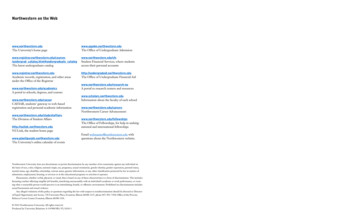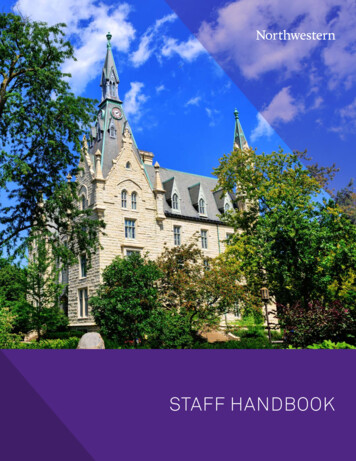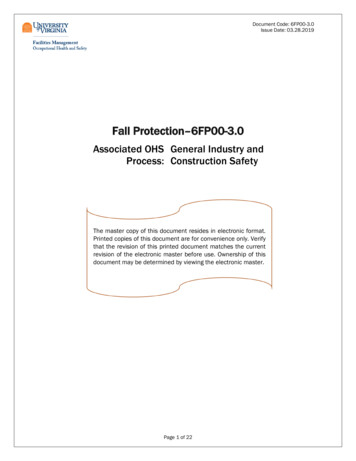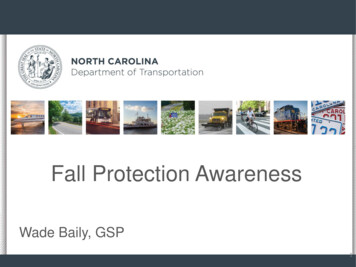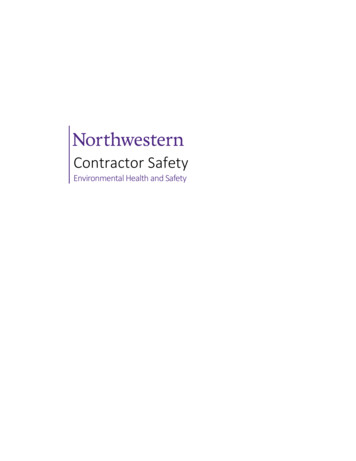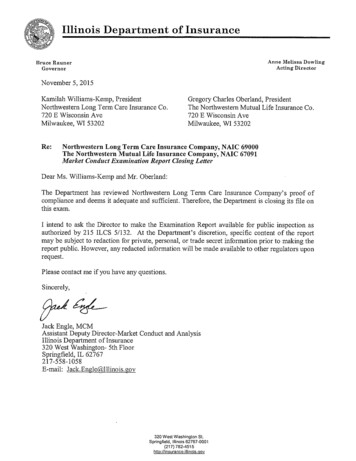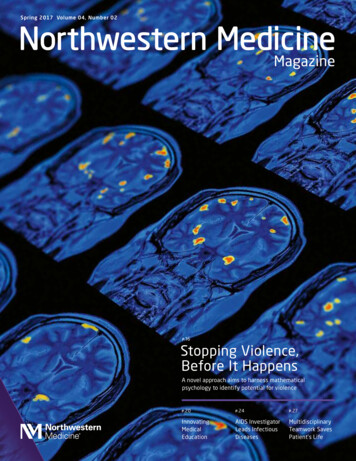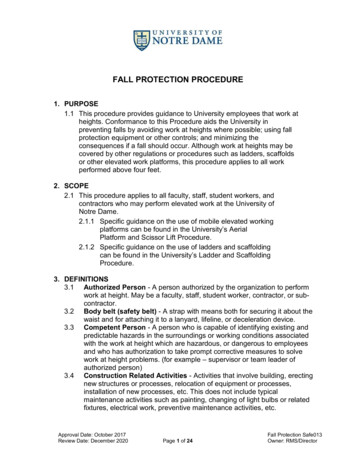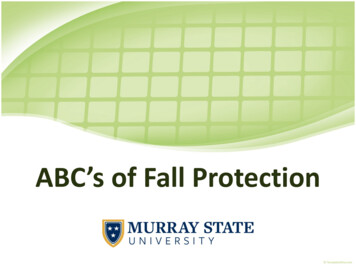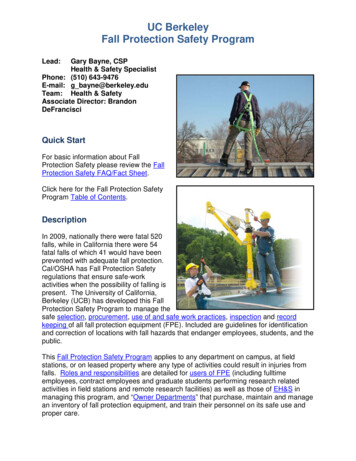
Transcription
Fall ProtectionEnvironmental Health and Safety
Table of ContentsI.Purpose . 3II.Scope. 3III. Responsibilities . 3IV. Fall Hazard Assessment . 4V.Fall Hazard Requirements . 4VI. Standard Fall Protection Systems . 6VII. Protection from Falling Objects . 7VIII. Emergency Procedures . 8IX. Signage . 8X.New Construction and Renovation Projects . 8XI. Training . 9XII. Recordkeeping . 9XIII. Regulatory Authority and Related Information . 10XIV. Contact . 10Appendix 1 – Fall Hazard Assessment Form . 11Appendix 2 – Example Fall Hazard Signage . 12Fall ProtectionEnvironmental Health and Safety June 20212
I.II.PurposeThis program establishes a process to protect individuals from the hazards associated with falls tolower levels on Northwestern property. This program provides guidance for the assessment,determination, and selection of fall protection equipment to perform tasks safely.ScopeThis program applies to contractors and Northwestern staff, faculty, and students who areexposed to fall hazards of 4 feet or more above a lower level on existing buildings. This programdoes not apply to contractor controlled worksites.The fall protection requirements of this program are exempt during inspecting, investigating, orassessing workplace conditions, or work to be performed prior to the start of work or after allwork has been completed. This exemption does not apply when acceptable/certified fallprotection systems or equipment are installed and available for workers to use for pre-work andpost-work inspections, investigations, or assessments.III.ResponsibilitiesA. Environmental Health and Safety (EHS)i.Review, audit, and revise this program as needed.ii.Conduct fall hazard assessments in response to reported or observed concerns,with assistance from Northwestern departments and units (e.g., providing workarea access, drawings and scope of work).iii.Review and approve fall hazard assessment forms (see Appendix 1) completedby Northwestern departments and units.iv.Provide consultation and guidance to Northwestern departments and units in theselection of appropriate personal fall arrest and protection equipment.v.Provide consultation and guidance to Northwestern project managers anddesign teams for the installation of temporary and permanent fall protectionsystems on existing buildings, new construction, renovation, and re-roofingprojects.vi.Identify training needs, and coordinate external or internal fall protectiontraining.B. Northwestern Departments and Unitsi.Adhere to the requirements of this program.ii.Conduct fall hazard assessments (see Appendix 1) for all work within 15 feet ofunprotected edges with fall hazards of 4 feet or more.iii.Ensure required staff, faculty, and students are trained as authorized persons inthe use and care of fall protection equipment.iv.Must have a trained, competent person who can identify hazards and has theauthority to take prompt, corrective measures.v.Provide fall protection equipment and financial resources to replace fallprotection equipment as needed.vi.Designate individual(s) to inventory, inspect, and maintain fall protectionequipment in accordance with maintenance and inspection schedules,recommendations, and procedures provided by the manufacturer or certifyingengineer.Fall ProtectionEnvironmental Health and Safety June 20213
vii.Monitor and ensure contractor compliance with this program.viii.Contact EHS to evaluate any safety concerns, or as specified in this program.C. ContractorsWhere fall hazards exist on existing buildings and renovation projects, contractors must:i.Conduct fall hazard assessments,ii.Develop and implement a site-specific fall protection program to protectcontractor employees from fall hazards,iii.Provide the fall protection program for inspection upon request,iv.Ensure contractor employees are trained and meet the requirements ofAuthorized Persons,v.Designate a competent person who meets the requirements of a CompetentPerson on all jobsites that have fall hazards, andvi.Supply and maintain fall protection equipment, as required.IV.Fall Hazard AssessmentV.Fall Hazard RequirementsA fall hazard assessment is required for all work at heights of 4 feet or more within 15 feet froman unprotected edge.A. Northwestern departments and units must designate a competent person to evaluateall work utilizing the Fall Hazard Assessment Form (see Appendix 1).B. EHS will review the fall hazard assessment form, provide recommendations andguidance, and grant final approval for work to commence by signing the form.There are many fall hazards at Northwestern that require fall protection and have specificrequirements, such as, but not limited to:A. Dangerous EquipmentRegardless of the potential fall distance, individuals must be protected from falling intoor onto dangerous equipment by a guardrail system or fall restraint system, unless it iscovered or guarded to eliminate the hazard.B. Fixed Ladders that Extend More than 24 Feet above a Lower Leveli.Fixed ladders installed prior to November 19, 2018 must be equipped with apersonal fall arrest system, ladder safety system, cage, or well.ii.Fixed ladders installed, modified, or repaired after November 19, 2018 must beequipped with a personal fall arrest system or a ladder safety system.iii.A cage or well in combination with a personal fall arrest system or ladder safetysystem may be used, provided the cage or well does not interfere with theoperation of the system.iv.On and after November 18, 2036, all fixed ladders must be equipped with apersonal fall arrest system or a ladder safety system.C. Floor Openings, Holes, and Wall Openingsi.Individuals must be protected from tripping or stepping into or through holes orfloor openings (including skylights) greater than 2-inches in its least dimensionwith covers or guardrails.ii.Individuals must be protected from gaps or open spaces in walls, partitions,vertical surfaces, or similar surface that are at least 30-inches high and at least18-inches wide.Fall ProtectionEnvironmental Health and Safety June 20214
D. Mobile Elevated Work Platforms (MEWPs)Refer to Northwestern’s Mobile Elevated Work Platforms Program.E. Rooftopsi.When work is less than 15 feet from an unprotected edge on a low-slope roof,users must use a guardrail system, fall restraint system, or personal fall arrestsystem.ii.When work is more than 15 feet from an unprotected edge on a low-slope roof,users:a. Must use a guardrail, fall restraint, or personal fall arrest system, orb. May use a work rule, authorized by a competent person and supervisor,prohibiting individuals from going within 15 feet of the unprotectedroof edge if the work is both infrequent and temporary. The work rulemay be established in a written work procedure, Fall HazardAssessment Form (see Appendix 1), or pre-job briefing for thesupervisor to review with all individuals performing the work. The workrule is not a substitute for fall protection and may only be used afterevaluating the hazards.iii.Fall Protection System DrawingsAll rooftops that contain permanent fall protection systems (e.g., anchor posts,horizontal lifelines) must have copies of the annual inspections and licensedengineer-approved system drawings posted in a conspicuous manner at the roofaccess point (e.g., hatch, window, door). Drawings must include a detailedlayout of all fall protection equipment, limitations, number of users, and anyother relevant information pertaining to the fall protection systems.iv.Contact EHS for all anticipated work on high-slope roofs (slope greater than 4inches of vertical rise for every 12-inches of horizontal length).F. Scaffoldsi.Scaffolds must meet the requirements of 29 CFR 1926, Subpart L (Scaffolds).ii.Self-contained, adjustable scaffold must have a guardrail system if the platform issupport by the frame; if supported by a rope system, a personal fall arrest systemand guardrail system must be used.iii.When guardrails are not feasible, personal fall protection systems must be usedand attached by a lanyard to a vertical lifeline, horizontal lifeline, or scaffoldstructural member.iv.Under no circumstances may personal fall protection systems be attached to ahandrail.v.No scaffold may be erected, moved, dismantled, or altered, except under thesupervision of a competent person.vi.Scaffolds may not be altered or moved horizontally while they are in use.vii.Scaffolds and scaffold components must be inspected by a competent personbefore each work shift, and after any occurrence which could affect a scaffold'sstructural integrity.G. Stairwaysi.Stairway floor holes must be protected by guardrails on all exposed sides,except at the stairway entrance.ii.Each flight of stairs with at least 3 treads and 4 risers must be equipped withstair rail systems and handrails.iii.Handrails must be 30- to 38-inches in height as measured from the leading edgeFall ProtectionEnvironmental Health and Safety June 20215
of the stair tread.Stair rail systems installed before January 17, 2017 must be at least 30-inches inheight as measured from the leading edge of the stair tread.v.Stair rail systems installed after January 17, 2017 must be at least 42-inches inheight as measured from the leading edge of the stair tread.H. Weather ConsiderationsWeather forecasts should be examined prior to the commencement of outdoor work.Consideration should be given to suspend work if wet or icy conditions may createadditional hazards. Employees are prohibited from working outdoors during storms,visible lighting, audible thunder, and/or high winds when using personal fall protectionsystems.iv.VI.Standard Fall Protection SystemsFall protection system selection must be based on a fall hazard assessment (see Appendix 1)that includes the type of work performed, location, environment, and fall distance. Below arethe standard fall protection systems to protect individuals from falls to lower levels.A. CoversEach cover must be capable of supporting, without failure, at least twice the maximumintended load that may be imposed on it at any one time and be secured to preventdisplacement.B. Designated AreasDesignated areas are not conventional fall protection systems or engineering controls,but an alternative fall protection method utilizing a warning line system that is onlyeffective when set up and used correctly and safely.i.EHS must approve all uses of Designated Areas through the use of a Fall HazardAssessment Form (see Appendix 1).ii.Warning line systems must be installed and inspected by a competent personupon erection and before each use.C. Guardrail Systemsi.Provide a barrier to prevent individuals from falling to lower levels, anddesignate an area in which work may take place without the use of additionalfall protection equipment. Guardrails are typically the most effective type of fallprotection.ii.Guardrail systems must consist of a toprail 42-inches ( /- 3-inches) above thewalking-working surface and midrail, installed midway between the walkingworking surface and the top rail (e.g., 21-inches). Intermediate verticalmembers may be used in lieu of midrails, if installed no more than 19-inchesapart.iii.Temporary guardrail systems must be visually inspected by a competent personprior to any work; any deterioration or deficiencies which may cause theguardrail system to fail must be documented and corrected prior to workcommencing.D. Ladder Safety Systemsi.Allows the user to climb up and down using both hands and does not require theindividual continuously hold, push, or pull any part of the system while climbing.ii.Requires the use of a body harness that is connected to the rigid or flexiblecarrier or lifeline along the length of the ladder.Fall ProtectionEnvironmental Health and Safety June 20216
iii.Must be certified and annually inspected.E. Personal Fall Protection Systemsi.Use guardrails and covers when feasible before using personal fall arrest or fallrestraint systems.ii.Personal fall protection systems must:a. Limit the maximum arresting force on the individual to 1,800 poundsand bring the individual to a complete stop within 3.5 feet;b. Be stored in a well-ventilated, clean, dry area free from temperatureand humidity extremes, corrosive materials, or other contaminants.c. Be inspected by a competent person prior to each use for wear,damage, and other deterioration, and be inspected and certified by aqualified person annually.d. Be ANSI-approved and not be used for any other purpose (e.g., hoistingequipment or materials).iii. Ropes, lanyards, and harnesses must be compatible with all connectors,anchors, and lifelines used and protected from damage (e.g., cuts, abrasions,melting).iv.Lanyards and lifelines must have a minimum breaking strength of 5,000 pounds,and D-rings, snaphooks, and carabiners must be capable of sustaining a minimumtensile load of 5,000 pounds.v.Snaphooks and carabiners must be the automatic-locking type that require atleast two separate, consecutive movements to open.vi.Body harness D-rings must be located in the center of the user’s back nearshoulder level; body belts are not permitted at Northwestern.vii.Anchorages must be capable of supporting at least 5,000 pounds for eachindividual attached, or be designed, installed, and used under the supervision ofqualified person as part of a complete personal fall protection system thatmaintains a safety factor of at least two. Anchorages must be annually inspectedby a qualified person.viii.Horizontal lifelines must be designed, installed, and used under the supervisionof a qualified person, and part of a complete personal fall arrest system thatmaintains a safety factor of at least two. Lifelines must be annually inspected bya qualified person.F. Rope Descent SystemsRope descent systems require annual inspection and must be re-certified by a qualifiedperson who is certified through the manufacturer:i.At least every 10 years, or sooner as needed,ii.As required by the manufacturer, andiii.If the system has been placed under tension as a result of a fall.VII. Protection from Falling ObjectsIndividuals must wear ANSI Z89.1 head protection when exposed to falling objects. In addition,protect individuals from falling objects by implementing one or more of the following:A. Erect toeboards along all exposed edges of overhead walking-working surfaces toprevent objects from falling to a lower level.B. Where tools, equipment, or materials are piled higher than the top of the toeboard,install paneling or screening from the toeboard to the midrail for a length that isFall ProtectionEnvironmental Health and Safety June 20217
sufficient to protect individuals below, or to the toprail if the items are piled higher thanthe midrail. Guardrail openings must be small enough to prevent objects from fallingthrough.C. Erect canopy structures that are strong enough to prevent collapse and penetrations byfalling objects, and keep potential falling objects far enough from edges, holes, andopenings to prevent them from falling to a lower level.D. Barricade the area into which objects could fall, prohibit individuals from entering thebarricaded area, and keep objects far enough from an edge or opening to prevent themfrom falling to a lower level.VIII. Emergency ProceduresA. Any work involving fall hazards greater than 4 feet requires the development of rescueprocedures based on the tasks performed, surrounding environment, and availability ofresources to ensure the safest and quickest method of rescue is employed. Rescueprocedures must be documented in the Fall Hazard Assessment (see Appendix 1).B. Sufficient means for communication in the event of a fall must always be in place.C. In the event of a fall requiring rescue, call 911 immediately.D. In the event of a fall:i. Permanent fall protection equipment (e.g., anchors, lifelines) must beinspected, repaired, or replaced if necessary, and re-certified by a qualifiedperson prior to it returning to service.ii. Temporary fall protection systems (e.g., warning lines, portable anchors) mustbe inspected prior to returning to service.iii. All other fall protection equipment (i.e., body harnesses, lanyards, and selfretracting lifelines) must be inspected by a competent person and repaired orreplaced if found to be damaged prior to it returning to service.IX.SignageX.New Construction and Renovation ProjectsA. Post fall hazard danger signage in a conspicuous manner at the roof access point (e.g.,hatch, window, door) where individuals have potential exposure to rooftop fall hazards,regardless of the distance to the fall hazards.B. Post fall hazard danger signage in a conspicuous manner in elevated work areas (e.g.,platforms, pits) with fall hazards.C. See Appendix 2 for an example fall hazard danger sign.A. Permanent fall prevention and protection measures must be included as an integral partof the design phase for all construction and renovation/repair projects.B. All walking-working surfaces where individuals are exposed to fall hazards (e.g., roofsystems, ladders, skylights, floor openings) must be permanently guarded or havequalified anchorages or lifelines for personal fall protection systems.C. All safe access and fall hazards associated with operations and maintenance must beidentified, and design measures must be instituted to mitigate these hazards. It isessential to solicit comments from Facilities Operations and EHS concerning specificneeds for safe access.D. Refer to Northwestern Design Guidelines for Safe Access and Fall Protection.Fall ProtectionEnvironmental Health and Safety June 20218
XI.TrainingXII.RecordkeepingIndividuals who are exposed to fall hazards, utilize fall protection equipment and systems, andsupervise work involving fall hazards, must be trained. Training must be delivered to eachindividual in a manner that the individual understands. Different types of training include:A. Authorized Person Trainingi.Recognizing and evaluating fall hazards and control methods.ii.Proper use, inspection, maintenance, and storage of fall protection equipmentor systems.iii.Understanding fall protection system limitations and proper hook-up,anchoring, and tie-off techniques.iv.Following the work rules and guidelines set forth by the competent person, andconsult with the competent person when in doubt.v.Training is required when any of the following scenarios occur:a. New employee on-boarding,b. Job-transfer that results in the potential for an employee to be exposedto fall hazards, orc. Whenever a competent person deems training to be necessary.vi.EHS will deliver authorized person training.B. Competent Person Trainingi.All of the responsibilities and requirements of authorized persons.ii.Supervising authorized persons performing work at heights and using fallprotection systems.iii.Taking prompt, corrective measures to eliminate fall hazards.iv.Completing fall hazard assessments, fall protection plans, and rescueprocedures.v.EHS will deliver competent person training.C. Refresher Trainingi.Competent and authorized persons must receive refresher training every threeyears, at a minimum.ii.EHS will deliver competent and authorized person refresher training.D. RetrainingRetraining will be provided to any competent or authorized person if and when any ofthe following scenarios occurs:i.Changes in the workplace or types of fall protection systems/equipment renderprevious training obsolete or inadequate.ii.When inadequacies in an individual’s knowledge or use of fall protectionsystems or equipment indicate the individual no longer has the requisiteunderstanding or skill necessary to use the equipment or perform the job safely.iii.Post-incident.A. Facilities:i.Provide departments, units, and contractors with the permanent fall protectionsystem documentation associated with buildings, upon request.ii.Maintain applicable records for permanently-installed fall protection systems,including:a. Building name and number,Fall ProtectionEnvironmental Health and Safety June 20219
b.c.d.e.f.g.Type of fall protection system installed,Certificate of inspection,Equipment manufacturer,Date of installation,Company that installed the system,Name and contact information of certifying engineer who certified theequipment, andh. Date of last certification/recertification.B. Northwestern Departments and units:i.Maintain employee training records,ii.Maintain fall protection equipment records (i.e., certifications, inventories, andinspection reports), andiii.Maintain Fall Hazard Assessment Form records.XIII. Regulatory Authority and Related InformationNorthwestern and contractors will comply with the Occupational Safety and HealthAdministration’s (OSHA) standards and any other applicable codes and standards, including:OSHA 29 CFR 1910 Subpart D – Walking-Working SurfacesOSHA 29 CFR 1926 Subpart M – Fall ProtectionOSHA 29 CFR 1926 Subpart L - ScaffoldsANSI Z359.2 – Minimum Requirements for a Comprehensive Managed Fall Protection ProgramNorthwestern Mobile Elevated Work Platform (MEWP) ProgramXIV. ContactFor questions, contact Environmental Health and Safety at ehs@northwestern.edu.Fall ProtectionEnvironmental Health and Safety June 202110
Appendix 1 – Fall Hazard Assessment FormFall Hazard Assessment FormAll work involving fall hazards of 4 feet or more in height requires an assessment using this form. Use only one form per task or project.Building & Location:Date(s) of Work:Scope of Work:Department or Unit:Area TypeYNArea AccessYNReason for AccessYBuilding RooftopStairsElectricalWork PlatformFixed LadderMechanicalCeiling/Overhead AreaPortable LadderRepairsFloor/Wall OpeningCeilingCleaningPipe Chase/Utility ShaftDoorPreventative MaintenanceOther:Vertical/Horizontal HatchWork with Contractorsft. Other:Fall Distance/Height of Work:Other:Potential HazardsYNPotential HazardsYNPotential HazardsYFloor Openings/Skylights/ManholesSloping/Unstable SurfacesHidden Drop-OffsSlip/Trip HazardsMoving PartsWall OpeningsWeather (e.g., High Wind, Rain, Lightning)Difficult AccessLow LightOther:Leading-Edge WorkProtruding ObjectsRoof Work LocationYNRequirementsControlsYGuardrail System/ParapetsWithin 15 ft. of anMust use guardrails, fall restraint, or personal fallCoversunprotected edgearrest system.Fall RestraintFall ArrestMust use guardrails, fall restraint, or personal fallDesignated Area (specify details in comments)More than 15 ft. from anarrest system, or, for infrequent/temporary work,unprotected edgemay use a work rule prohibiting workers fromWork Rule (specify communication in comments)going within 15 ft. of unprotected edges.Other:Personal Fall Arrest EquipmentYN Personal Fall Arrest Equipment YNFalling Object ControlsYTemporary AnchorShock-Absorbing LanyardHousekeepingPermanent AnchorSelf-Retracting Lifeline (SRL)ToeboardsMobile Fall Protection CartSRL-Leading Edge (SRL-LE)Net/Screen/CanopyHorizontal LifelineFull-Body HarnessBarricadeOther:Lifeline/Rope GrabRelocate Equipment/ToolsOther:Other:LanyardRescue PlanYNCritical Rescue FactorsSelf-RescueDetail any additional rescue plans, procedures, or factors that may affect rescue below:(e.g., anchor locations, potential landing areas, obstructions or other hazards)Portable LadderMobile Elevated Work PlatformFire Department (911)DeterminationYNReason for Declination (if applicable)YEquipment NeededIf “Yes,” work may proceed with above-selected controls and equipment. If“No,” select the reason(s) to the right or specify below:Training NeededCertification/Inspection NeededRescue Plan NeededAdditional CommentsDepartment or Unit Competent Person(print)EHS Representative(print)Fall ProtectionEnvironmental Health and Safety June 2021Authorization(sign)(date)(sign)(date)NNNNN11
Appendix 2 – Example Fall Hazard SignageFall ProtectionEnvironmental Health and Safety June 202112
Fall protection system selection must be based on a fall hazard assessment (see . Appendix 1) that includes the type of work performed, location, environment, and fall distance. Below are the standard fall protection systems to protect individuals from falls to lower levels. A.
